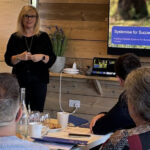In our last chapter in the series, Digital Transformation is Business Transformation, we explored the importance of mindset before change, to ensure you can shift your processes, which sets your direction.
This week, we take the next step in achieving an invincible digital transformation by developing a vision and strategy. So, let’s jump in.
Before jumping into tools or tactics, get clear on where you’re heading.
Every thriving business, no matter how small, has one thing in common: direction.
It’s easy to get swept up in digital transformation. New tools, new platforms, and new promises appear almost daily. But without a clear sense of why you’re doing it and where you’re going, it’s just noise.
So pause for a moment.
- What does success actually look like for your business?
- What kind of life and work are you trying to build?
- What do your customers really need from you?
A clear vision connects your everyday work to your bigger goals. It turns constant activity into genuine progress.

Vision first, then strategy
Your vision is your destination. Your strategy is the route that gets you there.
This sounds simple, but many micro business owners skip this step completely. They dive straight into marketing or software decisions before deciding what they actually want their business to become.
That’s like setting off on a journey without a map. You’ll move, but you might not end up where you hoped.
Before you do anything else, define your three building blocks:
- Purpose — Why do we exist? The deeper reason your business matters.
- Mission — How do we achieve that purpose?
- Vision — Where are we heading? What does success look like in five years?
These three statements form the backbone of your five-year strategy. They give you language, direction, and clarity — the DNA of your business.

If you’re a solo business owner
If you’re working on your own, this process still matters — maybe even more.
Start by reviewing your business plan. If you don’t have one yet, you’re not alone. Around half of UK micro businesses don’t. But now’s the time to fix that.
A simple plan helps you think clearly about your goals, challenges, and direction. There are plenty of templates and organisations that can help, often for little or no cost. Your local growth hub, chamber of commerce, or business advisor is a good place to start.
Think of your business plan as the first page of your strategy story.
Keep it simple
A strategy doesn’t need to be long or complex. The best ones fit on a single page.
Start with three meaningful priorities for the next six to twelve months — goals that move you closer to your five-year vision.
For example:
- Strengthen your online presence.
- Simplify your customer communication.
- Launch one new product or service.
Focus creates momentum.
 Practical takeaway: The “Vision Bridge”
Practical takeaway: The “Vision Bridge”
Try sketching your Vision Bridge — a one-page visual that links your present to your future.
| Now (Today) | Bridge (Actions) | Future (Vision) |
| How things work now | Three or four short-term priorities | What success looks like in five years |
Keep it visible. Revisit it every month. It’s your reminder of what matters most.
Case Study: Oakvale Community Theatre CIC finds its direction

When Oakvale Community Theatre CIC approached us, they were doing incredible work: local performances, youth engagement, and community events. But their days were consumed by admin, grant reports, and coordination chaos.
Their manager, Sophie, put it simply:
“We were constantly doing things, but we didn’t know which things were moving us forward.”
We started with a two-part Purpose, Mission and Vision Workshop to dig into the theatre’s DNA.
Part 1: uncovering why Oakvale existed and what the team stood for.
Part 2: shaping a five-year vision that reflected their ambition and community role.
Together, the team defined:
- Purpose: To make theatre accessible and meaningful for everyone in our community.
- Mission: To deliver creative, inclusive performances and projects that inspire participation.
- Vision: To become a sustainable, community-led venue known for local talent and creative learning.
Once that clarity was in place, Sophie could align the team, volunteers, and funders around a shared direction.

The strategy that followed was simple:
- Introduce digital ticketing.
- Build a volunteer communication system.
- Launch a digital newsletter to strengthen community ties.
Six months later, Oakvale wasn’t doing more; they were doing better.
“Once we knew our purpose, the path became clear,” Sophie says. “It’s like the fog lifted.”
OKRs: A tool for the next stage

As your business grows and your vision becomes clearer, you can layer in more structured goal-setting tools like OKRs (Objectives and Key Results).
An Objective is what you want to achieve.
A Key Result is how you’ll measure progress toward it.
For example:
Objective: Strengthen our local presence in Okehampton.
Key Results:
- Increase website traffic by 20%.
- Gain 50 new newsletter subscribers.
- Host two in-person community events.
OKRs help you stay accountable without losing sight of your purpose. They’re ideal for teams or businesses ready to formalise their strategy without overcomplicating it.
Align your support
Whether you work with freelancers, agencies, or volunteers, share your vision. A clear sense of direction helps everyone deliver better results and stay focused on what really matters.
When your support network knows where you’re heading, your business starts to move like a team, not a collection of parts.
Strategy is your focus filter
A good strategy doesn’t just tell you what to do. It helps you say no.
When the next tool, platform, or trend comes along, hold it up against your vision.
“Does this move me closer to my five-year goals?”
If not, leave it. Focus is how small businesses build resilience.
Final thought
Before you automate or advertise, take the time to define your purpose, mission, and vision.
Real transformation doesn’t start with tools. It starts with clarity. Once you know who you are and where you’re heading, everything else — design, systems, marketing – starts to fall into place.
Up next in the series






